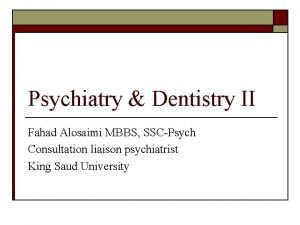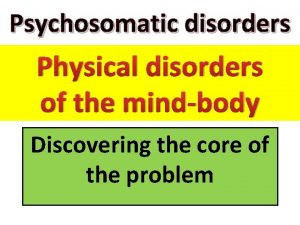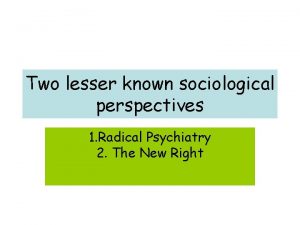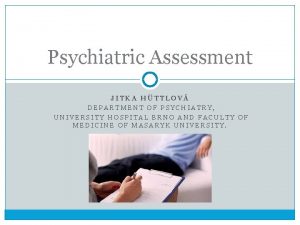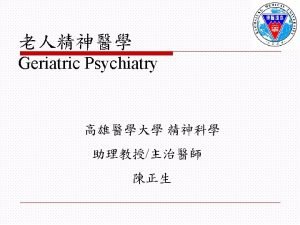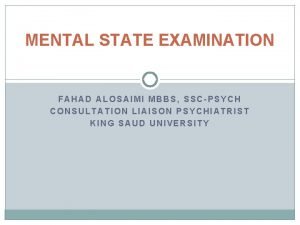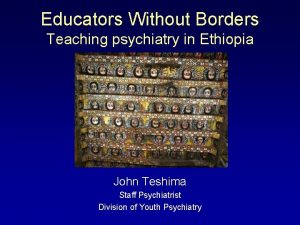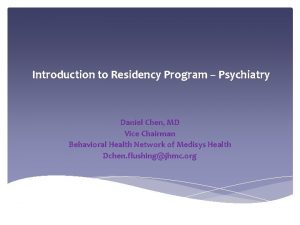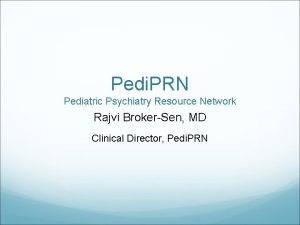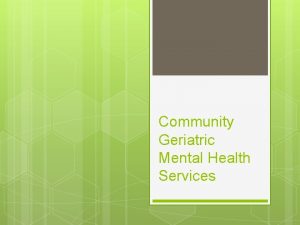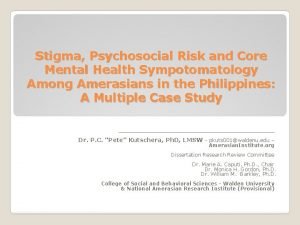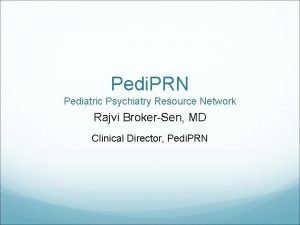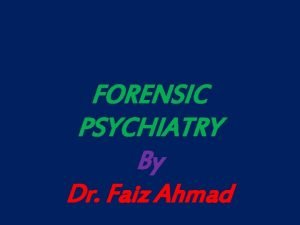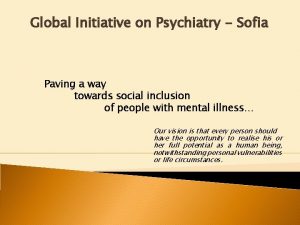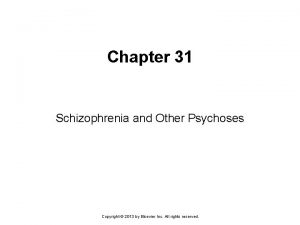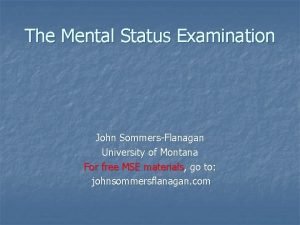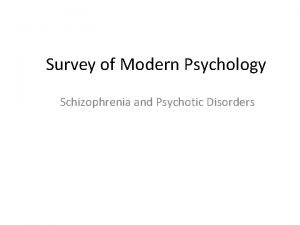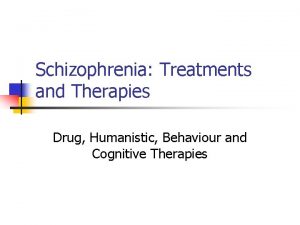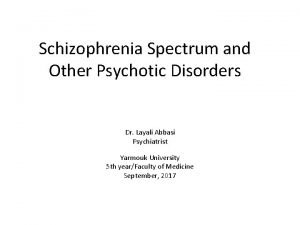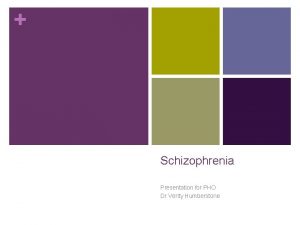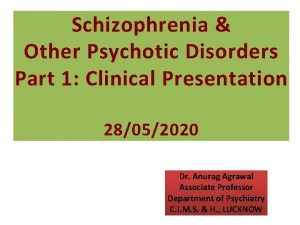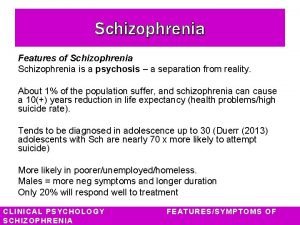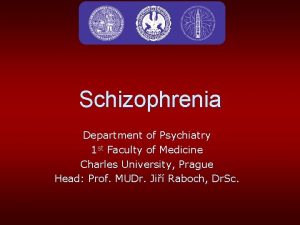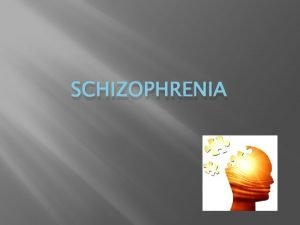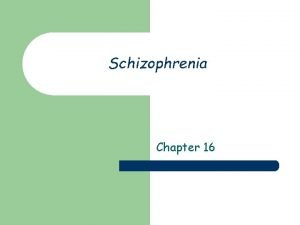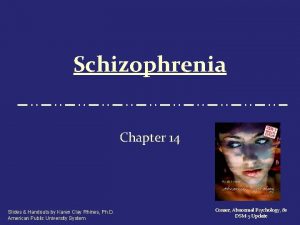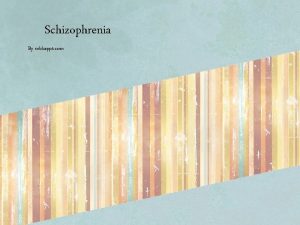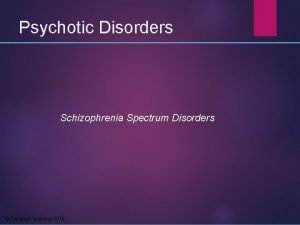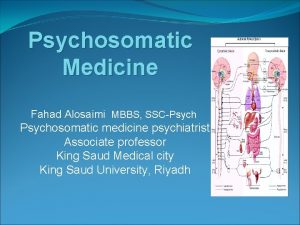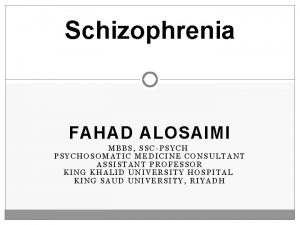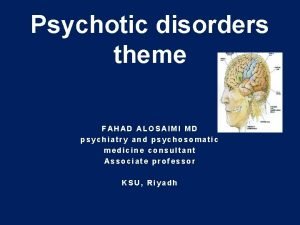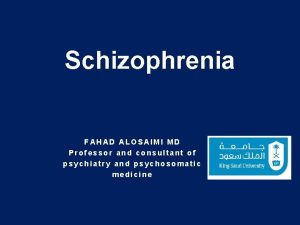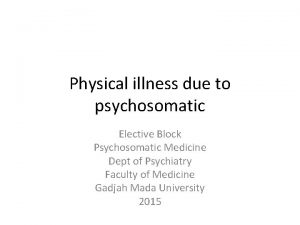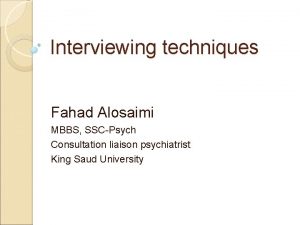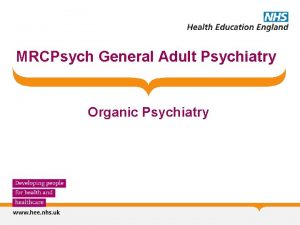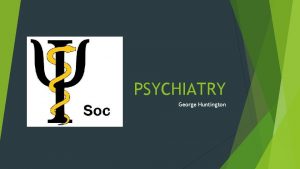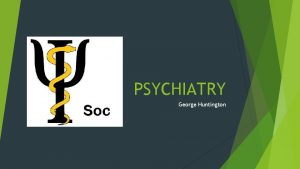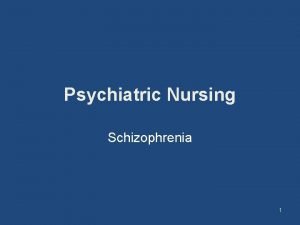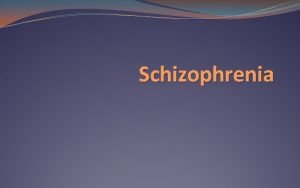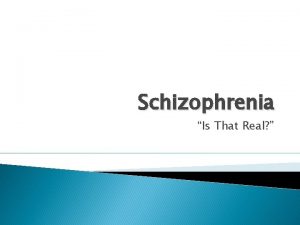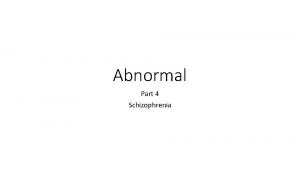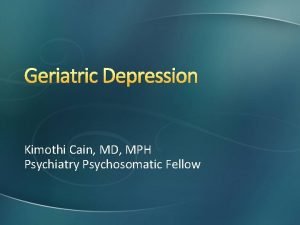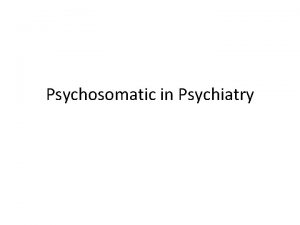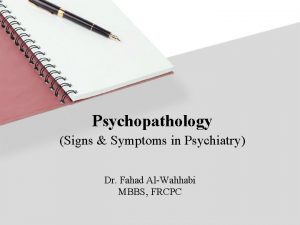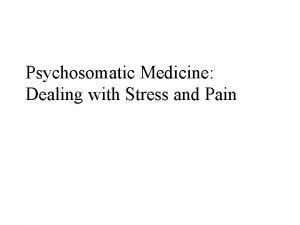Schizophrenia FAHAD ALOSAIMI MD psychiatry and psychosomatic medicine







































- Slides: 39

Schizophrenia FAHAD ALOSAIMI MD psychiatry and psychosomatic medicine consultant Associate professor KSU, Riyadh

Case of Mr. Schi is a 28 year-old single male who was brought to Emergency room by his family because of gradual changes in his behavior started 9 months ago. Since then, he became agitated; eat only canned food but not cooked food made by his family, afraid of being poisoned. He talks to himself and stares occasionally on the roof of his room.

Case of Mr. Schi He had two brief psychiatric hospitalizations in last 3 years that were precipitated by anger at his neighbor and voices commenting about his behavior. His personal history indicated that he was a healthy child, but his parents reported that he was a bed wetter and seemed slower to develop than his brothers and sisters. Schi smokes tobacco frequently to calm himself. During his early adolescence he used to smokes Hash heavily plus occasional use of amphetamine. He stopped both Hash and Amphetamine use 5 years ago.

Both has schizophrenia Lives at group home for the mentally ill Won Nobel prize

Intended Learning objectives By the end of this lecture, a student should be able to: v. Appreciate that schizophrenia is a serious, brain illness that needs early intervention and comprehensive management approach. v. Enhance his knowledge of schizophrenia including epidemiology, etiology, diagnosis and management. v. Acquire preliminary skills to evaluate and intervene adequately to manage schizophrenic patients.

Schizophrenia - It is not a single disease but a group of disorders with heterogeneous etiologies. - Found in all societies and countries with equal prevalence & incidence worldwide. - A life prevalence of 0. 6 – 1. 9 % - Annual incidence of 0. 5 – 5. 0 per 10, 000 - Peak age of onset are 10 -25 years for ♂ & 25 -35 years for ♀

http: //image. slidesharecdn. com/schizophrenia 1 -090716160801 -phpapp 02/95/schizophrenia 1 -5 -728. jpg? cb=1247760507

Etiology Exact etiology is unknown. 1 - Stress-Diathesis Model: q. Integrates biological, psychosocial and environmental factors in the etiology of schizophrenia. q. Symptoms of schizophrenia develop when a person has a specific vulnerability that is acted on by a stressful influence.

2 - Neurobiology * Certain areas of the brain are involved in the pathophysiology of schizophrenia: the limbic system, the frontal cortex, cerebellum, and the basal ganglia. a- Dopamine Hypothesis; Too much dopaminergic activity ( whether it is ↑ release of dopamine, ↑ dopamine receptors, hypersensitivity of dopamine receptors to dopamine, or combinations is not known ). b- Other Neurotransmitters; Serotonin, Norepinephrine, GABA, Glutamate & Neuropeptides

http: //www. medscape. org/viewarticle/585155



c- Neuropathology; Neuropathological and neurochemical abnormalities have been reported in the brain particularly in the limbic system, basal ganglia and cerebellum. Either in structures or connections.

http: //stahlonline. cambridge. org/essential_4 th_chapter. jsf? page=chapter 4_summary. htm&name=Chapter%204&title=Summary

http: //www. schizophrenia. com/disease. htm

d- Psychoneuroimmunology; ↓ T-cell interlukeukin-2 & lymphocytes, abnormal cellular and humoral reactivity to neurons and presence of antibrain antibodies. These changes are due to neurotoxic virus ? or endogenous autoimmune disorder ? e- Psychoneuroendocrinology; Abnormal dexamethasone-suppression test ↓ LH/FSH A blunted release of prolactin and growth hormone on stimulation.

3 - Genetic Factors - A wide range of genetic studies strongly suggest a genetic component to the inheritance of schizophrenia that outweights the environmental influence. - These include: family studies, twin studies and chromosomal studies.


4 - Psychosocial Factors: q. In family dynamics studies, no well-controlled evidence indicates specific family pattern plays a causative role in the development of schizophrenia. q. High Expressed Emotion family : increase risk of relapse.

Weight of different RF: Family history comes first PLOS Medicine

Schizophrenia: genes plus stressors Schizophrenia is mostly caused by various possible combinations of many different genes (which are involved in neurodevelopment, neuronal connectivity and synaptogenesis) plus stressors from the environment conspiring to cause abnormal neurodevelopment. There is also abnormal neurotransmission at glutamate synapses, possibly involving hypofunctional NMDA receptors. Stephen M The Genetics Of Schizophrenia Converge, Upon, The NMDA Glutamate Receptor, CNS Spectr. 2007

Diagnosis # DSM-5 Diagnostic Criteria for Schizophrenia: A- ≥ two characteristic symptoms for one month, at least one of them is (1), (2) or (3) 1 - Delusions 2 - Hallucinations 3 - Disorganized speech (frequent derailment or incoherence) 4 - Grossly disorganized or catatonic behavior 5 - Negative symptoms ( diminished emotional expression or lack of drive (avolition))

B- Social, Occupation or self-care dysfunction C- Duration of at least 6 months of disturbance (include at least one month of active symptoms that meet Criterion A; in addition of periods of prodromal and residual symptoms). D- Schizoaffective & mood disorder exclusion E- The disturbance is not due to Substance or another medical condition. F- If there is history of autism spectrum disorder or a communication disorder of childhood onset, schizophrenia diagnosis is made only if delusion or hallucinations plus other criteria are present.

Clinical Features q. No single clinical sign or symptom is pathognomonic for schizophrenia q. Patient's history & mental status examination are essential for diagnosis. q Premorbid history includes schizoid or schizotypal personalities, few friends & exclusion of social activities. q Prodromal features include obsessive compulsive behaviors , attenuated positive psychotic features.

- Picture of schizophrenia includes positive and negative symptoms. - Positive symptoms like: delusions & hallucinations. - Negative symptoms like: affective flattening or blunting, poverty of speech, poor grooming, lack of motivation, and social withdrawal.

Cognitive deficits in schizophrenia

Mental status examination - Appearance & behavior ( variable presentations) - Mood, feelings & affect ( reduced emotional responsiveness, inappropriate emotion) - Perceptual disturbances ( hallucinations, illusions ) - Thought: Thought content ( delusions) Form of thought ( looseness of association) Thought process ( thought blocking, poverty of thought content, poor abstraction, perseveration ) - Impulsiveness, violence, suicide & homicide - Cognitive functioning - Poor insight and judgment

Course Acute exacerbation with increased residual impairment Full recovery: very rare Longitudinal course: downhill


Prognosis Good P. F 1. Late age of onset 2. Acute onset 3. Obvious precipitating factors 4. Presence of mood component 5. Good response to Tx 6. Good supportive system 1. 2. 3. 4. 5. 6. 7. 8. Poor P. F Young age of onset Insidious onset Lack of P. F. Multiple relapses Low IQ Poor premorbid personality Negative symptom Positive family history

Differential Diagnosis Secondary psychiatric disorders: -Substance-induced disorders -Psychotic disorders due to another medical disorder : Epilepsy ( complex partial) CNS diseases Trauma Others Primary Psychiatric disorders: Schizophreniform disorder Brief psychotic disorder Delusional disorder Schizoaffective disorder Mood disorders Personality disorders ( schizoid, schizotypal & borderline personality) Factitious disorder Malingering

Criteria of other Psychotic Disorders q Psychotic Disorders due to another medical condition q Substance-induced psychotic disorder q Schizophreniform disorder ; 1 -6 month of disturbance q Brief psychotic disorder: <1 month of disturbance q Delusional disorder(delusion only >1 m) q Schizoaffective disorder: An uninterrupted period of illness during which there is a major mood episode (major depressive or manic) concurrent with Criterion A of schizophrenia. There is Delusions or hallucinations for 2 or more weeks in the absence of a major mood episode during the illness course.

Treatment What are the indications for hospitalization? Diagnostic purpose Patient & other's safety Initiating or stabilizing medications Establishing an effective association between patient & community supportive systems

Biological therapies q Antipsychotic medications are the mainstay of the treatment of schizophrenia. q Generally, they are remarkably safe. q Two major classes: -Conventional, (1 st generation) e. g. haloperidol, chlorpromazine. -Atypical, 2 nd generation (Serotonin-dopamine receptor antagonists) e. g. Risperidone, clozapine, olanzapine ). § Depot forms of antipsychotics eg. Risperidone Consta is indicated for poorly compliant patients. q Electroconvulsive therapy (ECT) for catatonic or poorly responding patients to medications

Pharmacolog ical Treatment Algorithm Adapted from the Maudsley prescribing Guidelines

Side effects of antipsychotics High Potency typical antipsychotics: Neurological side effects Low Potency typical and atypical antipsychotics: many other side effects

Common side effects of antipsychotic medication (Taylor et al, 2005)

Psychosocial therapies Social skills training Family oriented therapies Group therapy Individual psychotherapy Assertive community treatment Vocational therapy

Thank you
 Difference between psychosis and neurosis
Difference between psychosis and neurosis Psychosomatic
Psychosomatic Natisod in english
Natisod in english Radical psychiatry sociology
Radical psychiatry sociology Mse psych
Mse psych Geriatric psychiatry definition
Geriatric psychiatry definition Forensic psychiatry vs forensic psychology
Forensic psychiatry vs forensic psychology Thought content examples
Thought content examples Neurology shelf exam percentiles
Neurology shelf exam percentiles European psychiatry
European psychiatry Psychiatry in ethiopia
Psychiatry in ethiopia Jamaica hospital psychiatry residency
Jamaica hospital psychiatry residency Criminological psychology definition
Criminological psychology definition Addiction expert witness
Addiction expert witness National network of child psychiatry access programs
National network of child psychiatry access programs Community geriatric psychiatry
Community geriatric psychiatry Core psychiatry
Core psychiatry National network of child psychiatry access programs
National network of child psychiatry access programs Asclepiades father of psychiatry
Asclepiades father of psychiatry Feigned insanity forensic
Feigned insanity forensic Global initiative on psychiatry
Global initiative on psychiatry Chapter 31 schizophrenia and other psychoses
Chapter 31 schizophrenia and other psychoses Sample mse report
Sample mse report Catatonia
Catatonia Schizophrenia warning signs
Schizophrenia warning signs Humanistic approach to schizophrenia
Humanistic approach to schizophrenia Eugen beuler
Eugen beuler First-line treatment for schizophrenia
First-line treatment for schizophrenia Hebephrenic schizophrenia.
Hebephrenic schizophrenia. Genain sisters
Genain sisters Schizophrenia types
Schizophrenia types Thesis statement for schizophrenia
Thesis statement for schizophrenia Residual schizophrenia
Residual schizophrenia Hebephrenic schizophrenia
Hebephrenic schizophrenia Schizophrenia def
Schizophrenia def Schizophrenia disorganized behavior
Schizophrenia disorganized behavior Loose associations psychology
Loose associations psychology Hebephrenic schizophrenia
Hebephrenic schizophrenia Phases of schizophrenia
Phases of schizophrenia Double bind
Double bind
